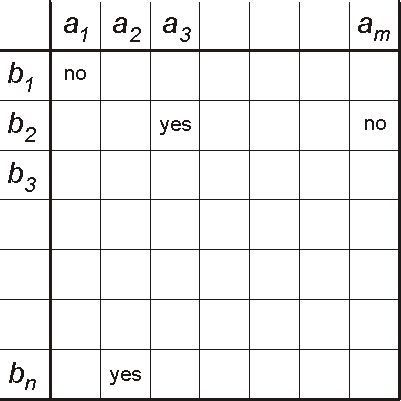Home
Erik Moberg ã:
A Theory of Democratic Politics
8.1 - TWO KINDS OF COMPROMISES
In part 8 I said that the actors' behavior was uncoordinated
when they just voted their minds, whereas coordination involved discussion
and negotiations between the actors. When coordinating, the actors are
thus likely to adjust their positions and behavior in various ways in order
to achieve benefits, for instance by forming and entering favorable decisive
constellations, or at least blocking ones. That of course requires compromises,
but political compromises may be of different kinds and the differences
are of considerable interest. Here I will describe two kinds of compromises.
Imagine two actors, A and B, which respectively
have the opinions, or take the positions, a1-am
and b1-bn.
Now, for any pair of positions with one position from each actor, it is
interesting to ask whether the positions are compatible or not. Each cell
in the figure below represents one such comparison, and a few answers are
also inserted as illustrations. Thus the positions a2
and bn, and a3
and b2, are compatible, whereas
the positions a1 and b1,
and am and b2,
are not compatible.
Now, in politics, both compatibility and non-compatibility
are common. In principle the issue of compatibility has to be judged in
each individual case, but two general rules, with possible exceptions,
may however be hypothesized.
-
Different ideological positions are likely to be in conflict
with each other, and thus not compatible. A society can, for instance,
not be built in accordance with both socialistic and capitalistic principles.
It has to be the one way or the other. Socialism and capitalism are not
compatible. Or, to take another example, a position on a spatial left-right
scale is not compatible with another position on the same scale. Thus,
an actor cannot adopt several positions on such a scale, it has to be just
one.
-
Positions about interests may, on the contrary, very well
be compatible. The position that a certain group in society, say small
farmers, should be supported is thus perfectly compatible with the position
that another group, say widows with small means, should also be supported.
There is no problem in adopting the two positions simultaneously.
Now compromises between political actors about political
positions may be of two types.
-
The first type of compromise consists in agreeing about a
common program involving compatible positions from the actors concerned.
Using the example in the figure the actors A and B may for
example compromise about a program involving A's positions a2
and a3 and B's positions
b2
and bn. The common policy
or program thus is a2 + a3
+ b2 + bn
+ ... . Such a compromise is likely to be quite easy to reach, since no
adjustments of original positions are needed. It is only required that
all actors feel that a fair amount of their original positions are included
in the final common policy.
-
The second type of compromise, which in the general case
should be much more difficult to reach, requires adjustments of positions
which originally are incompatible. An example would be a compromise between
A
and B in the figure about the positions a1
and b1. If both actors adjust
their positions they may finally become compatible, or perhaps even identical,
and thus represent a possible compromise. a1
and b1 may for instance be
two different positions on a spatial left-right scale, and the actors may
agree to settle for a specific position between a1
and b1. This is however likely
to be difficult since it requires that both actors change their original
positions in favor of a new one.
A conclusion to be drawn from the reasoning here thus
is that political compromises about interests are likely to be easier than
compromises about ideological matters.

